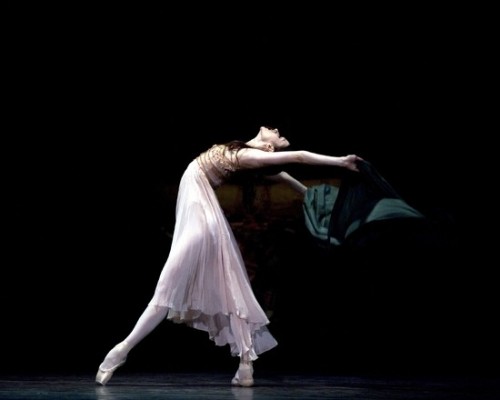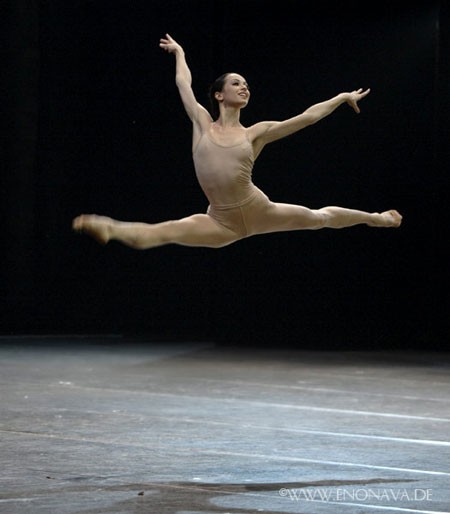Lady of the Camellias Through June 7
American Ballet Theatre at Lincoln Center in New York City
By: Ken Ross - Jun 02, 2010
Certain women haunt men their whole lives. They enthrall men with their sly smiles, their side-long glances over one shoulder, the way they arch their back like a cat, their mixture of vulnerability and assertiveness. One minute, they can't live without you. The next, they act like they never met you
If you’ve never met such a woman, consider yourself lucky. Literature, plays and operas are littered with spiritually-shipwrecked men whose lives were driven forever off course by spellbinding woman just out of reach most of their lives. Humbert Humbert never got over losing Lolita. Heathcliff longs for Cathy’s return in “Wuthering Heights.” Jay Gatsby stared for hours at a distant green light on East Egg, pining for Daisy Buchanan.
In “The Lady of the Camellias,” a superb, relatively- unknown ballet brought to life by American Ballet Theatre at Lincoln Center in New York, the ballet’s protagonist, Armand Duval, spends his whole life longing for Marguerite Gautier, a woman who enthralls him, even though she often acts like he doesn’t even exist.
These over-the-top, 19th century, Gothic emotions might seem out of place in today’s anything-goes, look-at-me Facebook world. And to be honest, going for a drink with Armand Duval would probably be as much fun as going on a road trip with Al Gore. (Yeah, we get it, Al. The world’s getting hotter. I told you we should have invited Clinton.)
But what makes this ballet work and feel fresh can be attributed mainly to the music. The entire, three-act ballet features the music of Frederic Chopin. Watching the ballet and listening to the music, one thought that kept running through my head is why hadn’t anyone else ever thought of doing this before?
Contemporary choreographer John Neumeier created “Lady of the Camellias” and first staged the ballet in Germany in 1978. The ballet is based on an 1848 novel of the same name written by Alexandre Dumas fils, the illegitimate child of the famous novelist. Chopin was a friend and contemporary of better-known Dumas in Paris until the composer died in 1849 of tuberculosis at the age of 39. (Chopin, by the way, has his own long-lost lover who haunted him after she left him. In Chopin’s case, the novelist nicknamed George Sand broke his heart when she left him in 1847.)
Chopin’s lively music perfectly suits the vast array of scenes in “Lady of the Camellias.” You need dance music? Chopin wrote waltzes, mazurkas and polonaises that could give Lady Gaga a run for her money on the dance floor. But it’s Chopin’s more intimate music that truly shines in “Lady of the Camellias.” Chopin’s emotionally-charged, musically-complex compositions for solo piano still feels as relevant and alive more than a century and a half later. So when the two lovers perform a pas de deux in Act 2 of the ballet, Chopin’s Sonata in B minor sets the perfect tone.
But we know this romance will not end well. We get a hint of this doomed love affair even during their first embrace in Act 1. They wrap their arms around each other again and again like vines clinging to a tree. They're trapped by their love. They’re smothering the life out of each other. (We also have a pretty good idea this guy is going down for the count during the next scene, when we see him sitting by the side of the stage still enraptured by their first encounter in her bedroom while we watch her flirt and dance with four other men on stage.)
It’s during intimate scenes like these between the two lovers where Chopin’s music sounds like something written for a silent movie. The only thing missing seems to be large cue cards flashing over the top dialogue. You know, the kinds of things said in almost every movie starring Tom Cruise. Listening to Cruise say such things on screen – or while jumping up and down on Oprah’s couch – might make us reach for the barf bag. But ballets and operas, in particular, have always been about oversized emotions. Maybe it’s because they don’t actually say these things in ballets. And when they do say them in operas, we don’t understand what they’re saying anyway, even when the lyrics are sung in English.
American Ballet Theatre’s principal dancers are taking turns playing the lead roles in “Lady of the Camellias.” On the evening of May 26, the lead role of Marguerite Gautier was performed by Irina Dvorovenko. The classically-trained, stunningly-beautiful Russian dancer has mesmerized ABT audiences ever since she became a principal dancer in the company in 2000. In recent years, she has had to compete with Russian superstar Diana Vishneva for the audience’s attention. Vishneva has proved in recent years she’s truly one of the world’s most amazing dancers. Vishneva possesses the amazing ability to convey complex emotions with the smallest of gestures that can be seen from even the highest balcony. But watching Dvorovenko in “Lady of the Camellias” reminded me why I first started selecting ballets with her performing in them years ago.
Like Vishneva, Dvorovenko has that rare ability to communicate with the audience as if she were whispering in our ears alone, a talent that seems to elude most America dancers. A long-time dance fan once told me years ago that if you want to know what separates good dancers from great or truly legendary ones, watch the dancer’s hands. I completely agree. Anyone can twirl and spin with athletic abandon. But it takes great skill to do that while also moving your fingers like a paint brush barely touching a canvas with soft, gentle strokes. Dvorovenko displays such subtlety in several scenes with Duval (played on May 26 by Cory Stearns) and in a short but memorable scene with Duval’s father (played on May 26 by Vitali Krauchenka) in Act 2. In the scene, Duval’s father demands Gautier stop seeing her son. With just a few slight movements of their hands and feet, the two dancers perfectly convey their dispute with each other.
Another memorable scene also occurs later in Act 2. When the young Duval receives a letter from Gautier that she is leaving him, he tosses the letter in the air and dances around it, like one of the possessed dancers in manically jumping around in a circle in Nijinsky’s ballet set to Igor Stravinsky’s “The Rite of Spring.” Duval keeps picking the letter up and reading it again and again, throwing it down on the ground in between readings as if the letter is trying to attack him – or in the hope that violently throwing the letter down onto the ground will somehow transform the heart-breaking words on the page.
I’m not going to get into all the intricacies of the plot here. Why spoil the ballet if you’re planning to see it performed by ABT at Lincoln Center on June 4, 5 or 7? Simply be prepared to be swept off your feet by lush, romantic music and top-notch dancing, something we’ve come to expect for decades at American Ballet Theatre, the best ballet company in the country. And if you’re not sure which night to see the ballet this weekend, be aware that Dvorovenko will be performing the lead role in the afternoon on June 5; Vishneva on the nights of June 4 and 7.
For tickets or for more information, go to www.abt.org
or call (212) 362-6000.



